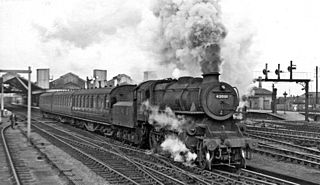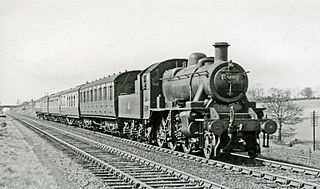
The Lakeside and Haverthwaite Railway (L&HR) is a 3.2-mile-long (5.1 km) heritage railway in Cumbria, England.
The London, Midland and Scottish Railway had the largest stock of steam locomotives of any of the 'Big Four' Grouping, i.e. pre-Nationalisation railway companies in the UK. Despite early troubles arising from factions within the new company, the LMS went on to build some very successful designs; many lasted until the end of steam traction on British Railways in 1968. For an explanation of numbering and classification, see British Rail locomotive and multiple unit numbering and classification.
Henry George Ivatt known as George Ivatt, was the post-war Chief Mechanical Engineer of the London Midland and Scottish Railway. He was the son of the Great Northern Railway locomotive engineer Henry Ivatt. George Ivatt was born in Dublin, Ireland, and educated at Uppingham School, England.

The steam locomotives of British Railways were used by British Railways over the period 1948–1968. The vast majority of these were inherited from its four constituent companies, the "Big Four".
The London Midland Region (LMR) was one of the six regions created on the formation of the nationalised British Railways (BR), and initially consisted of ex-London, Midland and Scottish Railway (LMS) lines in England and Wales. The region was managed first from buildings adjacent to Euston station, and later from Stanier House in Birmingham. It existed from the creation of BR in 1948, ceased to be an operating unit in its own right in the 1980s, and was wound up at the end of 1992.

The East Somerset Railway is a 2 1⁄2-mile (4 km) heritage railway in Somerset, running between Cranmore and Mendip Vale. Prior to the Beeching Axe, the railway was once part of the former Cheddar Valley line that ran from Witham to Yatton, meeting the Somerset and Dorset Joint Railway at Wells.

The BR Standard Class 3 2-6-2T was a class of steam locomotive designed by Robert Riddles for British Railways. It was essentially a hybrid design, the chassis being closely based on and sharing a number of parts with the LMS Ivatt Class 4, and having a boiler derived from a GWR No.2 boiler as fitted to the GWR Large Prairie 2-6-2T and 5600 Class 0-6-2T tank engines.

The London Midland and Scottish Railway (LMS) Fairburn Tank 2-6-4T is a class of steam locomotive. They were designed by Charles E. Fairburn for the LMS. 277 of these locomotives were built between 1945 and 1951, numbered in the range 42050–42186, (4)2187–(4)2299, (4)2673–(4)2699.

The LMS Ivatt Class 4 2-6-0 is a class of steam locomotive primarily designed for medium freight work but also widely used on secondary passenger services. The London Midland and Scottish Railway (LMS) built 162 of this type between 1947 and 1952, but only three were built by the LMS before nationalisation in 1948. Designed by H.G. Ivatt, they were classified 4F by the LMS and 4MT by BR. In BR days they were used extensively across the system, being prevalent on the London Midland region and to a lesser extent elsewhere, notably on the Midland and Great Northern Joint Railway, an East Anglian line that had previously been joint owned by the LMS and LNER, where they became the dominant locomotive type. They were also used for a short period on the Somerset and Dorset Joint Railway, but were quickly transferred elsewhere, never to return, because of poor steaming on the line's long and steep gradients – this was before modifications were made to the design which improved steaming notably.

The London, Midland and Scottish Railway (LMS) Class 2 Stanier 0-4-4T was a class of 10 light passenger locomotives built in 1932. Ostensibly designed under new Chief Mechanical Engineer (CME) William Stanier, they were in fact the last new design of the Midland Railway's school of engineering.

Sir William Stanier's London, Midland and Scottish Railway (LMS) Class 4P 2-Cylinder 2-6-4T is a class of 206 steam locomotive built between 1935 and 1943. They were based on his LMS 3-Cylinder 2-6-4T.

The London, Midland and Scottish Railway (LMS) Fowler 2-6-4T was a class of steam locomotive passenger tanks designed by Henry Fowler.

The BR Standard Class 3 2-6-0 was a class of mixed traffic steam locomotive designed by Robert Riddles for British Railways. It was essentially a hybrid design, the chassis being closely based on and sharing a number of parts with the LMS Ivatt Class 4, and having a boiler derived from a GWR No.2 boiler as fitted to the GWR Large Prairie 2-6-2T and 5600 Class 0-6-2T tank engines.

The Midland Railway 1833 Class was a class of thirty 0-4-4T steam locomotives. They are sometimes included with the earlier 1823 Class or the later 2228 Class.
This page is based on this
Wikipedia article Text is available under the
CC BY-SA 4.0 license; additional terms may apply.
Images, videos and audio are available under their respective licenses.















